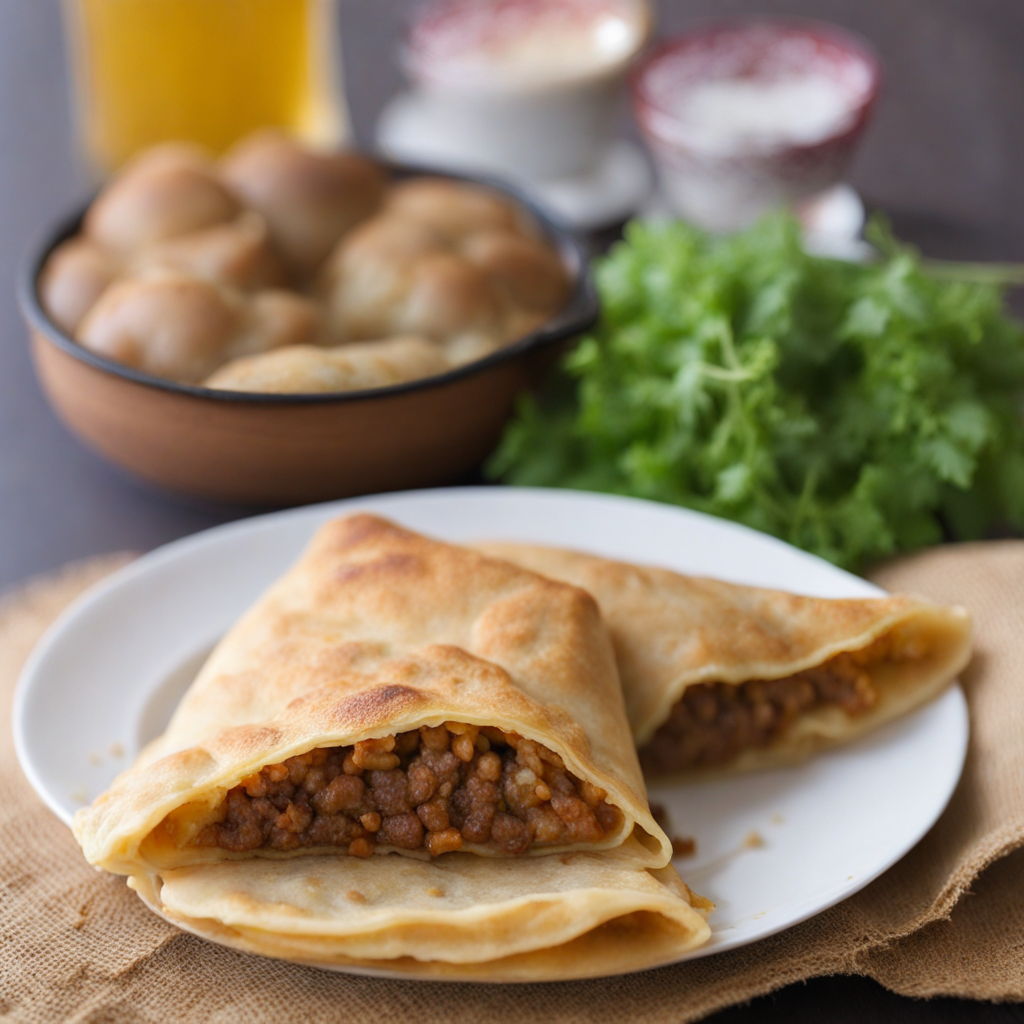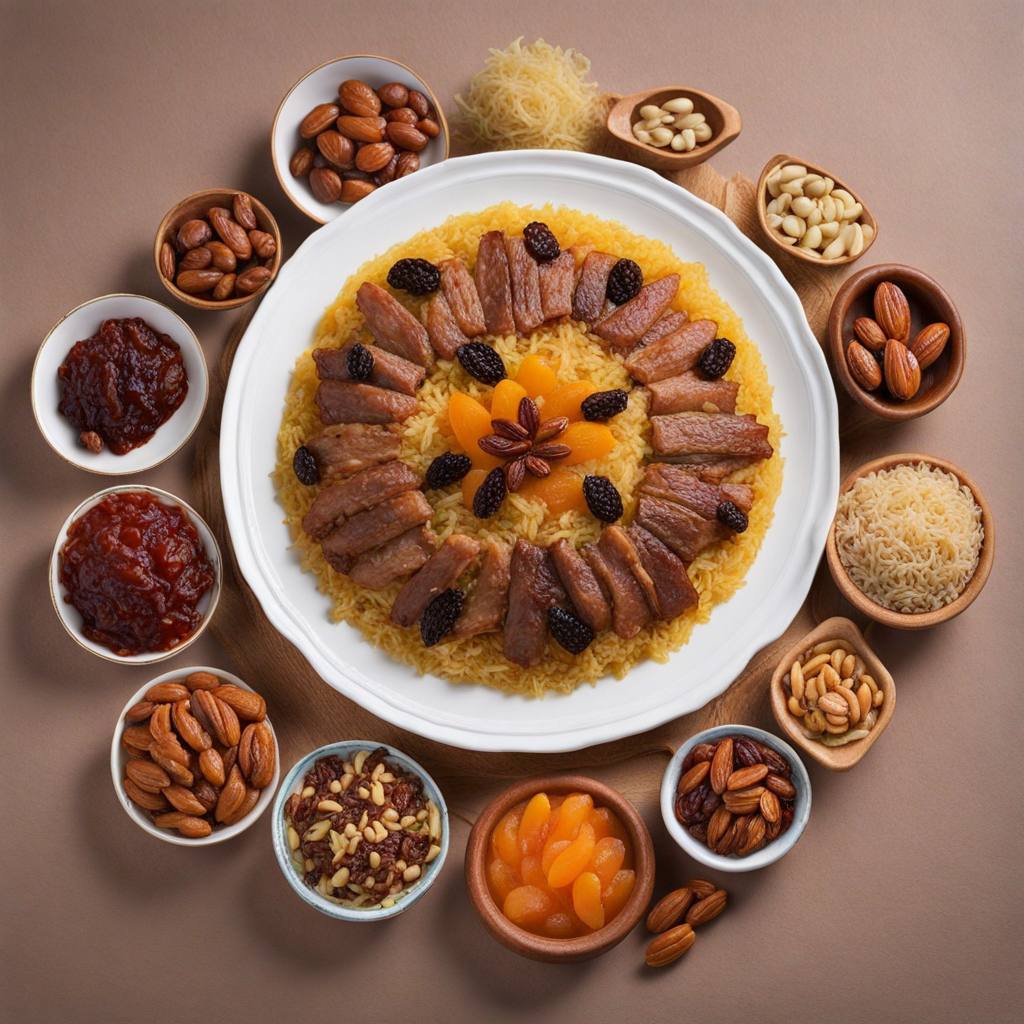Mutabbaq
Maqab, a traditional dish from Oman, embodies the rich culinary heritage of the Arabian Peninsula. This savory treat is a beloved staple, especially in the southern regions of Oman, where it is often enjoyed during festive occasions and family gatherings. The history of Maqab is deeply rooted in the Bedouin culture, where food was not only a source of sustenance but also a means of hospitality and community bonding. Over the years, it has evolved with various influences, reflecting the diverse flavors and ingredients available in the region. The foundation of Maqab lies in its unique flavor profile, which is a harmonious blend of spices and ingredients. The dish is characterized by its savory, slightly spiced taste, often enhanced with the warmth of cumin, coriander, and turmeric. The filling, typically made with minced meat—beef or chicken—infuses the dish with rich umami notes, while the addition of onions, garlic, and sometimes chilies adds depth and a hint of sweetness. The preparation of Maqab is an art form; each layer is carefully crafted to ensure a balanced flavor in every bite. Preparation of Maqab involves a multi-step process that begins with the dough, which is made from simple ingredients like flour, water, and a pinch of salt. The dough is kneaded until it reaches a soft, pliable consistency, and then allowed to rest. Meanwhile, the filling is prepared by sautéing the meats with chopped onions, garlic, and a mix of spices, creating a fragrant
How It Became This Dish
The History of مطبق (Maqtab) from Oman Maqtab, a beloved dish from Oman, is not just a meal; it is a culinary emblem steeped in history and cultural significance. This stuffed flatbread, often filled with a variety of ingredients, represents the rich tapestry of Omani culinary traditions that have evolved over centuries. To understand the origins and significance of Maqtab, we must delve into Oman's history, its geographical context, and the cultural exchanges that have shaped its cuisine. #### Origins and Geographical Context Oman is situated on the southeastern coast of the Arabian Peninsula, bordered by the Arabian Sea and the Gulf of Oman. Throughout history, this strategic location has made Oman a melting pot of cultures and influences, with traders and travelers passing through its lands. The region's diverse geography, characterized by coastal plains, rugged mountains, and vast deserts, has also played a crucial role in shaping its agricultural practices and food sources. Maqtab's origins can be traced back to the traditional Omani way of life, where food was not merely sustenance, but a reflection of the land and its people. The dish is thought to have roots in the ancient practices of bread-making, a skill that has been passed down through generations. The flatbread that forms the base of Maqtab is akin to the traditional khubz, a staple in Omani households. However, what sets Maqtab apart is its unique filling, which can vary based on local customs and available ingredients. #### Cultural Significance In Oman, food plays an integral role in social gatherings, celebrations, and daily life. Maqtab is often prepared during festive occasions, family gatherings, and communal meals, serving not only as a dish but as a vehicle for connection and hospitality. The preparation of Maqtab can be a communal activity, involving family members working together to create the dough, prepare the fillings, and cook the bread. This collaborative effort fosters a sense of belonging and strengthens familial bonds. The ingredients used in Maqtab reflect the agricultural bounty of Oman. Traditional fillings often include seasoned meats, such as chicken or lamb, mixed with vegetables, herbs, and spices. The use of spices like cumin, coriander, and turmeric not only enhances the flavor but also highlights the influence of various cultures that have traded with Oman over the centuries. As a result, Maqtab can be seen as a culinary representation of Oman's rich history of trade and cultural exchange. #### Development Over Time The evolution of Maqtab over the years mirrors the broader changes in Omani society and its culinary landscape. In the early days, the dish was primarily made using locally sourced ingredients, reflecting the agrarian lifestyle of the Omani people. As Oman began to engage more actively in trade, particularly with neighboring countries and beyond, new ingredients and cooking techniques began to influence the preparation of Maqtab. By the 20th century, with the advent of globalization, Omani cuisine, including Maqtab, started to incorporate flavors and methods from various parts of the world. For instance, the introduction of new spices and cooking equipment, such as electric ovens, revolutionized the way Maqtab was prepared. Traditional practices coexisted with modern influences, leading to a dynamic culinary scene where chefs and home cooks alike experimented with new flavors while respecting traditional methods. Regional variations of Maqtab also emerged, as different communities adapted the dish to suit their tastes and available ingredients. In coastal areas, seafood fillings became popular, while in the mountainous regions, the use of locally foraged herbs and greens enhanced the dish's flavor profile. These adaptations not only enriched the dish but also underscored the diversity of Omani culture. #### Contemporary Maqtab Today, Maqtab remains a cherished dish in Oman, celebrated for its versatility and flavor. It is commonly found in both homes and restaurants, often accompanied by traditional sides such as salad, dips, and sauces. The dish has transcended its humble beginnings to become a symbol of Omani hospitality, often served to guests as a sign of welcome and respect. In recent years, there has been a resurgence of interest in traditional Omani cuisine, driven in part by a growing emphasis on culinary heritage and sustainability. Chefs are increasingly looking to source local ingredients and revive traditional recipes, ensuring that dishes like Maqtab are not only preserved but also celebrated in modern culinary contexts. Food festivals and cultural events highlight Omani cuisine, providing opportunities for locals and tourists alike to experience the rich flavors and stories behind dishes like Maqtab. The global interest in Middle Eastern cuisine has also contributed to the popularity of Maqtab beyond Oman's borders. Food enthusiasts around the world are discovering and embracing this dish, leading to new interpretations and fusions that respect its origins while allowing for creativity. As a result, Maqtab is no longer confined to Omani tables; it has gained recognition as a dish worthy of celebration on the international stage. #### Conclusion Maqtab is more than just a culinary delight; it is a testament to Oman's rich history, cultural diversity, and the enduring importance of food in fostering community and connection. Its evolution over time reflects the dynamic nature of Omani society, where tradition and modernity coexist harmoniously. As Maqtab continues to be enjoyed by new generations, it remains a flavorful reminder of Oman’s past, present, and future—a dish that tells the story of its people and their love for hospitality, flavor, and connection.
You may like
Discover local flavors from Oman







